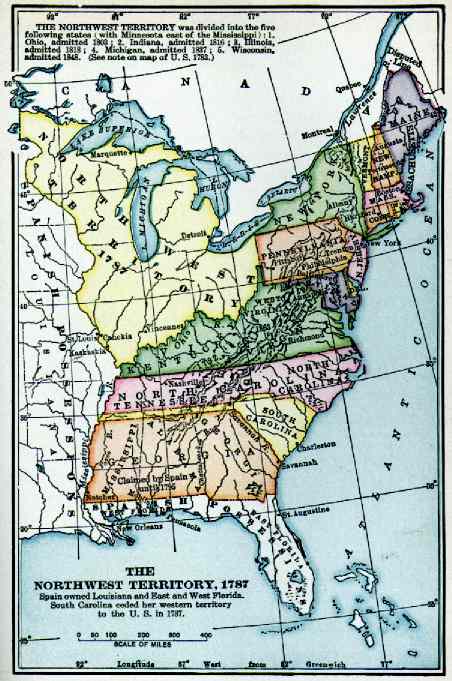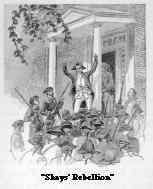Resource Center OLLibrary
|
1783-1787 ] |
|
171 |
But, generally speaking, the Articles proved
to be very unsatisfactory. Under them the nation could do but
little because
1. It had no President -- no head.
2. It had a Congress, but that Congress was
destitute of power. It might pass good and useful laws, but it
could not compel the people to obey them. It might beg the people
to give money, but it could not make them furnish it. It might ask
for soldiers to defend the country, but it could not force them to
serve.
193. Distressed Condition of the Country;
jealousy of the States; Lack of Freedom of Trade. The truth
is, that the people had come out of the war in a distressed
condition. They were heavily in debt. Business was at a
standstill. Gold and silver coin was scarce. The states had an
abundance of paper stuff which pretended to be money, but nobody
knew what it was worth, and what passed for a dollar in one state
might not pass at all in another. The distress and discontent grew
worse and worse. The states quarreled with each other about
boundary lines, about commerce, about trade. Instead of being a
united and. friendly people, they were fast getting to be thirteen
hostile nations ready to draw the sword against each other.
This feeling was shown in the fact that a man
could not buy and sell freely outside of his own state. If, for
instance, a farmer in New Jersey took a load of potatoes to New
York, he might have to pay a tax of five or ten cents a bushel to
that state before he could offer them for sale. On the other hand,
if a New York merchant sent a case of boots to New Jersey to sell
to the farmers, that state might, if it chose, tax him ten cents a
pair before he could get a permit to dispose of his goods.
194. "Shays' Rebellion" (1786-1787). The
people of Massachusetts were perhaps more heavily loaded with debt
than those of any other state. It is said that the heads of
families owed about two hundred dollars apiece. They were willing
to pay, but could get nothing to pay with. When great numbers of
poor people were sued and thrown into prison, multitudes became
desperate. In the western part of the state Daniel Shays raised an
army of
|
172 |
|
[1786-1787 |
|
nearly two thousand excited farmers (1786). They
surrounded the courthouses at Worcester and Springfield,
and put a stop to all lawsuits for debt. It was not until
a strong military force was sent out |

 against
them that the "rebellion" was finally quelled, and Shays
compelled to fly to New Hampshire.
against
them that the "rebellion" was finally quelled, and Shays
compelled to fly to New Hampshire.


